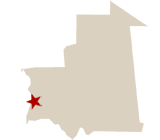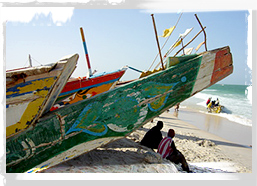An Introduction to Mauritania
Mauritania has two main populations, sub-Saharan Africans and Moors, and the territory has been dominated by Moorish and Arab conquerors for much of the last thousand years. A desperately poor desert nation, present-day Mauritania took shape when imperial France gradually absorbed territories from the Senegal river area, starting in the late 19th century. Incorporated into French West Africa from 1920, the country benefitted from legal prohibitions against slavery - which nevertheless persists in some forms to this day - and an end to interclan warfare. Most of the population remains nomadic. See full country profile.Latest Research News from Africa
1 current African job:

GOVERNMENT: military junta
AREA: 1,030,700 sq km
POPULATION: 3,281,634 (July 2011 est.)
MAJOR LANGUAGE: Official Language: Arabic

Some business and general info
The Market Research Industry
Trade and Industry in Mauritania
A little More Knowledge?
Go to next country
Mauritania has two main populations, sub-Saharan Africans and Moors, and the territory has been dominated by Moorish and Arab conquerors for much of the last thousand years. A desperately poor desert nation, present-day Mauritania took shape when imperial France gradually absorbed territories from the Senegal river area, starting in the late 19th century. Incorporated into French West Africa from 1920, the country benefitted from legal prohibitions against slavery - which nevertheless persists in some forms to this day - and an end to interclan warfare. Most of the population remains nomadic.
The country gained independence in 1960 and the capital city Nouakchott was founded at the site of a small colonial village, the Ksar. Only brief periods of democracy or quasi-democracy have interrupted military and one-party rule since then, and the current ruler, General Mohamed Ould Abdel Aziz, was installed by a military coup on 6 August 2008, although in April 2009 he resigned from the military to run for president in the 19 July electi'ns, which he won.About 20% of the population live on less than US$1.25 per day.
GDP: $6.655 billion (2010 est.) - $2,100 per capita (2010 est.)
Religions Sunni Muslim - close to 100%
Currency: Ouguiya (MRO) - GBP 1 = MRO 438 (see below 'low five')
Telephone Code: +222
Research Industry
There is no MR industry as such in Mauritania. However, it does hold a special place in our nerdy researchers' hearts, having been given the top level domain suffix... mr.Despite its rich natural resources Mauritania has one of the lowest GDPs in Africa. A majority of the population still depends on agriculture for a livelihood, even though most of the nomads and many subsistence farmers were forced into the cities by recurrent droughts in the 1970s and 1980s.
Oil was discovered in Mauritanian territory in 2001 in the offshore Chinguetti deposit, but it remains to be seen how this potentially significant wealth will help the country.
Mauritania has extensive deposits of iron ore, which account for almost 50% of total exports. With the current rises in metal prices, gold and copper mining companies are opening mines in the interior. $2.04bn of goods were exported from Mauritania in 2010, also including fish and petroleum, and the main export partners include China (43.8%), Italy, Japan, Spain and the Netherlands.
Imports totalled $1.9bn in the same period, and included machinery and equipment, petroleum products, capital goods, food and consumer goods. These came primarily from France and China, as well as other European and South American countries.
Email me:
laurence@mrweb.com

